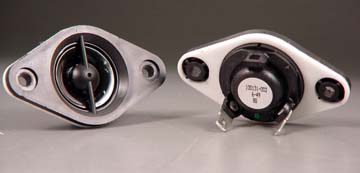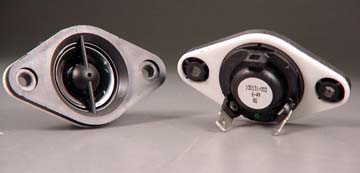The ubiquitous 1/2"...um....3/4"...er 1" ?? polycarbonate "dome" tweeter
Here's pretty much the version that has been around for decades i.e. small magnet + cone/dome design + glossy black surface + acoustic lens with pinhole in it:
Nuance TW5-2LR 1/2" Mylar Tweeter
This tweeter, in varied versions, has been around since the early 80s and seems to have been used by just about every low-end to mid-fi manufacturer since then, and not always constructed of polycabonate. I've seen it with a titanium surface layer, a clear blue cone/dome, and various other combinations.
So:
* is it a dome tweeter with a large surround? Or a very small cone tweeter with an acoustic lens?
* who originally manufactured it? And all the various versions over the years - were they designed by the same company or did the original company license the design?
A couple months ago I bought a pair of Philips SPA7210 PC speakers that are equipped with these tweeters (they are a light bronze color but no lens structure), so now I get to look at them a lot nowadays, which is partly why I finally posed this question! 😀
Here's pretty much the version that has been around for decades i.e. small magnet + cone/dome design + glossy black surface + acoustic lens with pinhole in it:
Nuance TW5-2LR 1/2" Mylar Tweeter
This tweeter, in varied versions, has been around since the early 80s and seems to have been used by just about every low-end to mid-fi manufacturer since then, and not always constructed of polycabonate. I've seen it with a titanium surface layer, a clear blue cone/dome, and various other combinations.
So:
* is it a dome tweeter with a large surround? Or a very small cone tweeter with an acoustic lens?

* who originally manufactured it? And all the various versions over the years - were they designed by the same company or did the original company license the design?
A couple months ago I bought a pair of Philips SPA7210 PC speakers that are equipped with these tweeters (they are a light bronze color but no lens structure), so now I get to look at them a lot nowadays, which is partly why I finally posed this question! 😀
The 1st ones i saw were Audax, and they made some of the best. There are a zillion knock-offs. The gold dome Audax were considered best of the lot.
either
dave
is it a dome tweeter with a large surround? Or a very small cone tweeter with an acoustic lens?
either
dave
Were these literally gold (gold plated I mean) or just gold colored?The gold dome Audax were considered best of the lot.
They vaguely remind me of the "donut" tweeter Advent used, along with the similarly shaped 5" midrange driver used in their 6003/Maestro model til the mid 90s.either
dave
I'm not sure on the 1st -- i do have a pair here somewhere.
Yes, similar to the Advent , the purple Wharfdale tweeters, and the CTS, but much smaller
dave
Yes, similar to the Advent , the purple Wharfdale tweeters, and the CTS, but much smaller
dave
Hi,
The driver was developed by Audax. The dome profile allowed a formerless
ribbon wound voicecoil to be immersed in the ferrofluided magnetic gap.
Countless cheap look a likes exist, especially in car audio, and they are
very poor compared to the Audax types. Copper coils on standard paper
formers compared to edge wound formerless aluminium for example.
Be careful out there, they are not all the same, some utter garbage,
and conversely some way far better than others if they are built well.
rgds, sreten.
The driver was developed by Audax. The dome profile allowed a formerless
ribbon wound voicecoil to be immersed in the ferrofluided magnetic gap.
Countless cheap look a likes exist, especially in car audio, and they are
very poor compared to the Audax types. Copper coils on standard paper
formers compared to edge wound formerless aluminium for example.
Be careful out there, they are not all the same, some utter garbage,
and conversely some way far better than others if they are built well.
rgds, sreten.
Last edited:
One way to tell the real Audax ones is that they have a square plastic cover over the magnet, and the whole motor assembly can be removed from the faceplate with a simple twist-lock.


Looks remarkably like the tweeter in the Rogers DB101:
Bafles Rogers Db 101 Origen Uk - Liniers - Electrónica - bafles an
Originally they cost £400 the pair but then Rogers reduced the price to just over half and promised refunds to those who paid full price.
Next thing you know Rogers is bankrupt and Richer Sounds sold them for £99.
Bafles Rogers Db 101 Origen Uk - Liniers - Electrónica - bafles an
Originally they cost £400 the pair but then Rogers reduced the price to just over half and promised refunds to those who paid full price.
Next thing you know Rogers is bankrupt and Richer Sounds sold them for £99.
My pair of "Hi-Fi" speakers have this design, they use a very fine aluminium former with copper coils immersed in FF, and a 4-5cm ferrite motor. Compared to the cheap "button" neo magnet found in the "co-axial" speakers I bought (for the woofers, lol), they are quite ok for the sound of the speaker.
There is something nice about the sound of the "balanced dome" tweeters, but they all seem to have some HF peak, i.e. cymbals are more "hiss" than cymbal... 😉
There is something nice about the sound of the "balanced dome" tweeters, but they all seem to have some HF peak, i.e. cymbals are more "hiss" than cymbal... 😉
Hi,
The later neo versions do only need a button magnet, not necessarily
cheaper or any worse. AFAICT diagphragm material is more about
offering options than any real performance benefits.

Thse Apex jr $1 specials are allegedly made by Audax and allegedly good.
Only way to be sure is buy 3 and strip one to check for the formerless
aluminium axially wound ribbon voice coil. (i.e. the coil has no layers,
its as thick as the ribbon is wide, quite difficult to make I assume.)
Some have experimented with opening up the pinhole, for tuning.
Typically filtered with just a capacitor, this combines with the ~
3kHz Fs to give an ~ 3 KHz 3rd order acoustic roll-off as in these :
Used them as nearfield desk moniotors in a small studio.
As shown above this is the rectangular option of the faceplate
the actual driver could lock into, instead of the above circular.
rgds, sreten.
It is the tweeter in the DB101, that based on the HiFi News
small kit speaker that used the Audax with a Rogers unit.
Both drivers in the DB101 are Audax made.
The later neo versions do only need a button magnet, not necessarily
cheaper or any worse. AFAICT diagphragm material is more about
offering options than any real performance benefits.

Thse Apex jr $1 specials are allegedly made by Audax and allegedly good.
Only way to be sure is buy 3 and strip one to check for the formerless
aluminium axially wound ribbon voice coil. (i.e. the coil has no layers,
its as thick as the ribbon is wide, quite difficult to make I assume.)
Some have experimented with opening up the pinhole, for tuning.
Typically filtered with just a capacitor, this combines with the ~
3kHz Fs to give an ~ 3 KHz 3rd order acoustic roll-off as in these :
An externally hosted image should be here but it was not working when we last tested it.
Used them as nearfield desk moniotors in a small studio.
As shown above this is the rectangular option of the faceplate
the actual driver could lock into, instead of the above circular.
rgds, sreten.
It is the tweeter in the DB101, that based on the HiFi News
small kit speaker that used the Audax with a Rogers unit.
Both drivers in the DB101 are Audax made.
Last edited:

Thse Apex jr $1 specials are allegedly made by Audax and allegedly good.
Steve says he is running low on those. I may have some sacrificial ones, so i may be able to "autopsy" one.
dave
Dave....
I still have quite a few of these in stock, say 4000 still in stock
and am still offering the DIY Audio 1/2 off sale at .50ea.
And on a side note I still know I owe you some, so will include
in your next order....
Steve
I still have quite a few of these in stock, say 4000 still in stock
and am still offering the DIY Audio 1/2 off sale at .50ea.
And on a side note I still know I owe you some, so will include
in your next order....
Steve
Steve,
I am never worried about being taken care of when it comes to doing business with you... probably need some more panelmount RCAs next, Daniel is smoking thru them
dave
I am never worried about being taken care of when it comes to doing business with you... probably need some more panelmount RCAs next, Daniel is smoking thru them
dave
Can that pinhole make a significant difference as far as sound quality? Because the other domes I have seen with lenses (phase plugs?) that include a hole, that hole is much larger than this tweeter's pinhole.Some have experimented with opening up the pinhole, for tuning.
Can that pinhole make a significant difference as far as sound quality?
Because the other domes I have seen with lenses (phase plugs?) that
include a hole, that hole is much larger than this tweeter's pinhole.
Hi,
One would assume the pinhole makes next to no difference, its styling.
I remember a UK kit speaker that claimed the provided tweeters had
an optimised modified opened up central hole, easy to say, but no
real hard evidence I recall that this was the case. Your right IMO
to have an effect the hole must be a lot larger. There again there
are fine tweeters with no central hole at all, so what gives ?
I don't know, here only measurements tell the truth.
rgds, sreten.
Mordaunt short have also used this style of tweeter I think before the last time they went bankrupt (they have gone bust a few times). In the speaker my friend owns they are are combined with an 8" ported woofer in a ~35L cab and work quite well.
How about a Foster 9324 tweeter? It looks to be a polycarbonate, it has a lens/ waveguide with three plastic arms holding a small cylinder above a black diaphragm.
In terms of what kind of dispersion it has, is all of the diaphragm that is visible the moving surface? I'm seeking a tweeter that would start beaming at about 10 kHz, and am wondering if the Foster would fit the bill.
Regards,
Pete
In terms of what kind of dispersion it has, is all of the diaphragm that is visible the moving surface? I'm seeking a tweeter that would start beaming at about 10 kHz, and am wondering if the Foster would fit the bill.
Regards,
Pete
Foster 9324
Removing the faceplate from the motor and diaphragm, the polycarbonate starts out first as a cone (concavity), then at the center is a small dome. The outside diameter of the polycarbonate is about 7/8" (22 mm).
Also I was wondering if the waveguide affects dispersion.
Removing the faceplate from the motor and diaphragm, the polycarbonate starts out first as a cone (concavity), then at the center is a small dome. The outside diameter of the polycarbonate is about 7/8" (22 mm).
Also I was wondering if the waveguide affects dispersion.
- Status
- Not open for further replies.
- Home
- Loudspeakers
- Multi-Way
- The ubiquitous 1/2"...um....3/4"...er 1" ?? polycarbonate "dome" tweeter